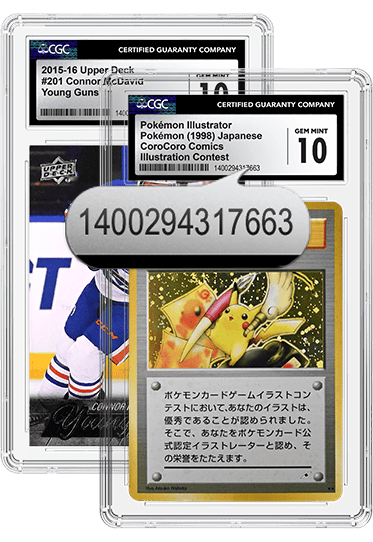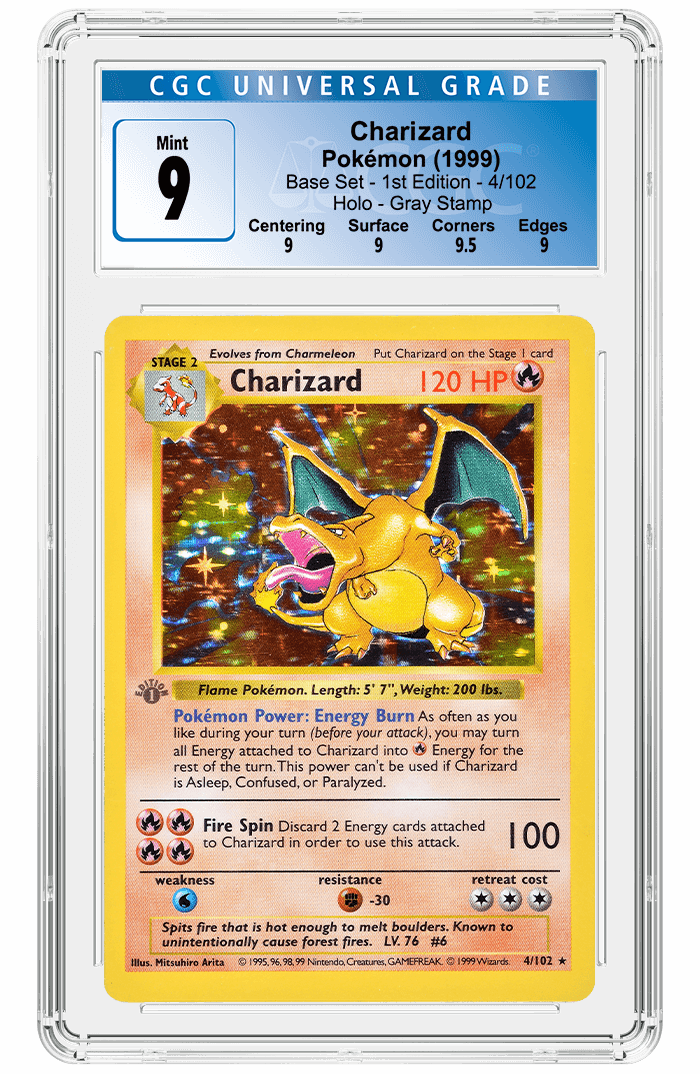The Rarest and Most Expensive Pokémon Cards
Posted on 8/12/2022
BREAKING NEWS: CGC Cards™ has certified two Prerelease Raichu cards! Using every resource at its disposal, including forensic technology, XRF scanning, consultants and specialized imaging techniques, CGC Cards confidently certifies that this pair of Prerelease Raichu cards are authentic. For more information, click here.
In October 1996, Japan’s Media Factory — now KADOKAWA Future Publishing — began printing the first series of Pokémon trading cards. Now spanning over 25 years' worth of content, eight generations of monsters and characters and over 43.2 billion individual card sales, it’s safe to say that the Pokémon Trading Card Game has made a lasting impact on not only collectors but the entire world.
Some Pokémon cards can go for hundreds, thousands and even millions of dollars, making them prized possessions for many collectors.
Value can be subjective, but Pokémon cards are generally considered rare and valuable if they’re hard to find. The fewer the number of cards released, the rarer and more expensive they are. For example, some cards only have 10 copies or less out in circulation, like the 1999 Super Secret Battle Trainer No. 1 promo (more on that later). These cards are extremely rare and valuable to collectors.
So then, what are the rarest and most expensive Pokémon cards? We’ve scoured years’ worth of archives, databases and articles to bring you a list of the 22 top cards in the history of the franchise. The sales data you find in this article comes from completed sales on trustworthy auction sites, including PWCC, Heritage Auctions and eBay, from 2019 onward.
The most expensive Pokémon card ever sold is the Pikachu Illustrator promo card, which was sold for a whopping $5,275,000 in 2022. It is considered the one of the rarest Pokémon card in existence, with only 39 copies ever distributed and 41 known to exist.
But, there are many other huge sales and rare cards. Here are the picks from CGC Trading Cards® for the rarest and most expensive Pokémon cards.
 |
The top 20 most expensive Pokémon cards
Number 20: Torchic Gold Star – EX Team Rocket Returns ($25,400)
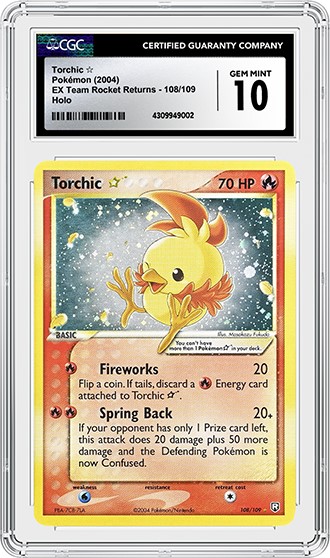 |
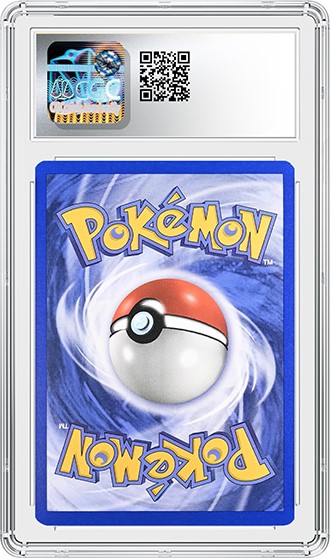 |
| A Torchic Gold Star, Pokémon (2004) EX Team Rocket Returns graded CGC Gem Mint 10. Click images to enlarge. |
|
Right away, you might be able to tell that there’s something special about this card. Unlike most cards in the series, Gold Star cards depict Pokémon in their shiny forms — a special, rare coloring that, up until recently, players of the video game franchise only had a 1/8192 chance of seeing. They might as well have the same rarity odds in the TCG, too; before Sword and Shield’s Shiny Vault and Radiant Collection, Gold Star and Shining cards were the only series to feature fan-favorite Pokémon in their rare colors.
Gold Star Pokémon cards are rare enough on their own, but this specific Torchic is one of the rarest of the lot. EX Team Rocket Returns came out during the “dark ages” of Pokémon when the series’ popularity was dwindling. That means that there were very limited print runs of the set. Additionally, Torchic Gold Star is a secret rare card, which means that collectors had one chance in every two boxes to pull the golden chicklet.
Collectors searching for an ungraded copy of the card can expect to pay around $600. A graded copy can go for more than $10,000, with one selling for $25,400 in a 2020 PWCC auction, making it one of the most valuable Pokémon cards.
Number 19: Espeon Gold Star — 2005 Japanese Play Promo ($25,700)
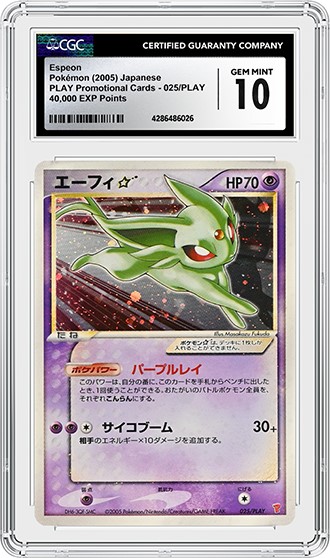 |
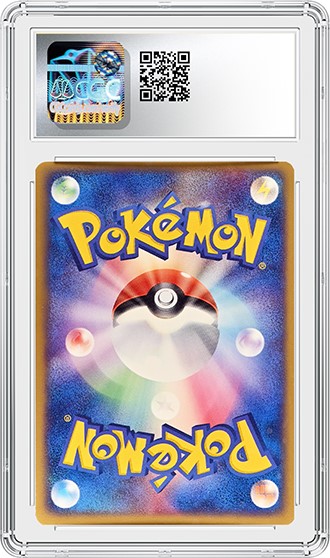 |
| An Espeon, Pokémon (2005) Japanese PLAY Promotional Card - 025/ PLAY - 40,000 EXP Points graded CGC Gem Mint 10. Click images to enlarge. |
|
Another popular Gold Star rarity, Espeon Gold Star is sought after by both English and Japanese collectors alike. While the Pop Series 5 English variant is also rare and expensive, the Japanese promo Espeon is in a league all its own.
Espeon Gold Star was only available to members of the Daisuke Pokémon Fan Club. Subscribers could earn EXP points during the club’s 2005-2006 tournament series by participating in official local events, hosting events, contributing to the club’s newsletter, and more.
Unfortunately, the Espeon Gold Star card required 40,000 EXP points. Considering subscribers only started with 1000 points for subscribing and got a minuscule average of 50-100 points for event participation, the coveted Eeveelution promo was extremely hard to obtain. The sheer difficulty of this card’s acquisition meant that there are now very few officially distributed copies in circulation, making them exceptionally rare and incredibly desirable by fans and collectors alike.
Collectors searching for an ungraded copy of this card can expect to pay around $18,000. A graded copy of this card has sold for as much as $25,700 in auction.
Number 18: Gold Pikachu — 2016 20th Anniversary Promo ($29,500)
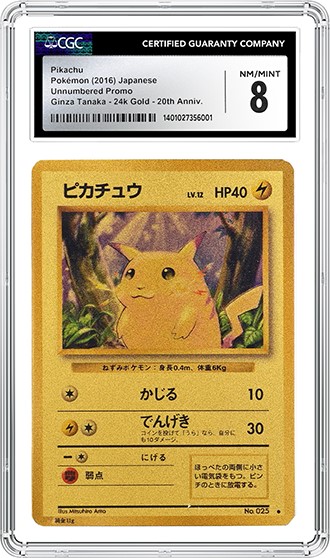 |
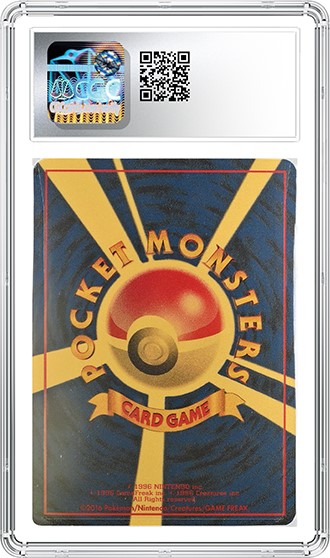 |
| A Pikachu, Pokémon (2016) Japanese Unnumbered Promo Ginza Tanaka – 24k Gold – 20th Anniversary Promo graded CGC 8. Click images to enlarge. |
|
Everybody knows Pikachu —the lovable mascot of the Pokémon series shows up in just about every piece of Pokémon media, including, of course, the trading card game. While Pikachu has appeared in several promotional cards and sets throughout the years, this is, by far, the most unique and rare instance.
This Gold Pikachu card is among the rarest and most expensive Pokémon cards. Why? Because the “Gold” in “Gold Pikachu” is quite literal. That’s right — this promo card is made of solid, 24-karat gold. This luxurious collectible was created in partnership with Japanese jewelry company Ginza Tanaka to celebrate the franchise's 20th anniversary in 2016. Collectors who wanted to purchase the rarity would need to first enter a lottery. If they were chosen, the buyer would then need to pay a princely sum of 216,000 yen (about $2,081) to seal the deal and receive the card. Gold Pikachu would arrive at collectors’ doorsteps adorned in a glass commemorative holder courtesy of Ginza Tanaka.
An example of this exclusive rarity realized $29,500 in a 2022 Goldin Auctions sale. CGC Cards graded another example in April 2024, and it later realized an impressive $30,700 in a Goldin sale. That’s not surprising, considering this rarity is made from solid gold.
Number 17: Master’s Key – 2010 Japan World Championships Promo ($30,000)
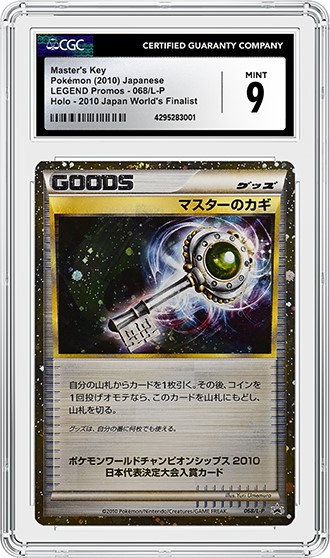 |
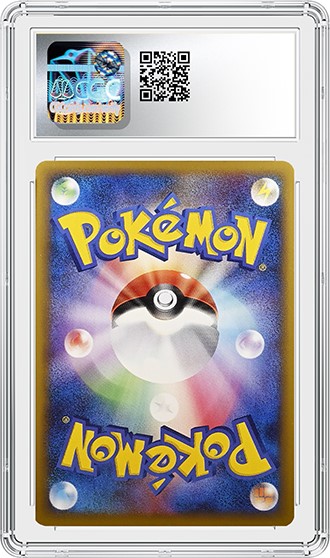 |
| A Master's Key, Pokémon (2010) Japanese LEGEND Promos - 068/L-P Holo - 2010 Japan World's Finalist graded CGC 9.Click images to enlarge. | |
The Master’s Key was given out to national finalists of the 2010 Japan World Championship Representative Tournament, which took place on June 20, 2010, at the Tokyo Dome City Prism Hall. Winners of the second stage of the TCG and Video Game qualifiers faced off to determine who would go on to the national championships. There were 36 winners across both platforms, which means that 36 of the Master’s Key cards were given out.
The special promo card was presented to the winners in acrylic plaques that came denoted with the winner’s placement, name, and which division of the tournament they were crowned the winner in — red plaques were given to TCG winners, while blue plaques were given to video game tournament winners. The top three winners of the TCG tournament (and the top four winners in the video game tournament) were also given copies of Pokémon Black and Pokémon White — the newest entries in the video game series that wouldn’t come out until September of that same year.
One copy of the Master’s Key sold for $26,900 in a past PWCC auction. More recently, another copy of the promo card sold for $30,000 on Heritage Auctions.
Number 16: No. 1-3 Trainer — 2002 Neo Spring & Summer Battle Roads ($34,000)
 |
 |
| A No. 2 Trainer, Pokémon (2002) Japanese Spring Battle Road 2nd Place Prize Promo graded CGC Gem Mint 10. Click images to enlarge. |
|
Numbered trainer cards were the staple in early 2000s Japan tournaments. First, second and third-place winners of each age bracket would receive personalized, gender-specific trainer cards, complete with text that specified their placement and — for first-place winners — instructions for how to enter the Japan nationals.
The 2002 Battle Road Spring and Summer Trainer variants are especially valuable, though, because they’re the last prize cards to feature complete customization for the winners. The 2002 No. 1-3 Trainer prizes were the last to personalize the winner’s name and the region they won the tournament in, making these cards especially rare.
Luckily, we know how many Japanese players were crowned first, second and third-place winners in the 2002 circuit, thanks to Vol. 16 of Trainers Magazine; a Japan-exclusive magazine that covered tournament events. According to the magazine, there were two female and 26 male first-place winners, two female and 25 male second-place winners, and four female and 50 male third-place winners. By totaling that up, we can infer that there are at least 109 officially distributed and personalized Trainer No. 1-3 prize cards in circulation.
In March of 2021, one of the male-variant No. 2 Trainer promos sold in a PWCC auction for $34,100. If you’re curious, the card was personalized for Fukunishi Tomoki, the second-place winner of the Kanto Summer Battle Road Junior Division tournament.
Number 15: Master’s Scroll — 2010 Daisuke Club Japanese Promo ($35,000)
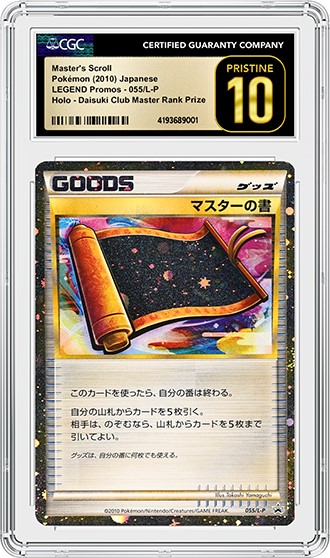 |
 |
| A Master's Scroll, Pokémon (2010) Japanese LEGEND Promos - 055/L-P Holo - Daisuki Club Master Rank Prize graded CGC Pristine 10.Click images to enlarge. | |
The Pokémon Daisuke Club is a Japanese Pokémon fan club that was responsible for distributing promotional cards until 2010. Subscribers to the club would compete in events, host tournaments, and participate in other events to earn Action Points, which they could then trade in for an exclusive promo card of their choice, like the system that awarded players the Gold Star Espeon promo we talked about earlier.
The Master’s Scroll was special because it was the last promo card to be given out by the Daisuke Club. The organization retired the Action Point system in June 2010, and with it, the promotional card distributions that they were known for.
Unfortunately for subscribers, players who wanted to get their hands on the elusive Master’s Scroll had to earn a whopping 8,600 Action Points to trade for the card. If the subscriber did manage to reach Master Rank and earn enough points to trade in for the exclusive promo, it would arrive in the mail complete with a customized Master Rank pamphlet and the card expertly sealed inside.
Since there were very few Master Rank trainers when the Action Point system was discontinued, it’s safe to say that the 2010 Master’s Scroll is incredibly rare. It’s no wonder, then, that a graded copy realized over $35,000 in a March 2021 PWCC auction.
Number 14: Victory Orb (Mew) — 2005-2006 Battle Road Promo ($40,000)
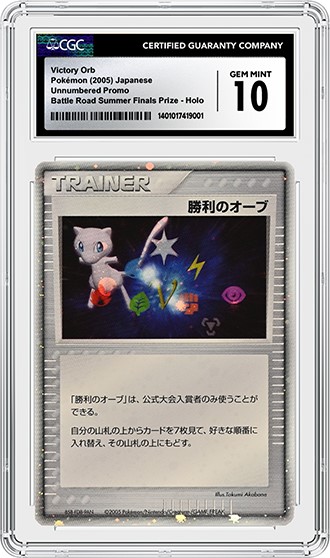 |
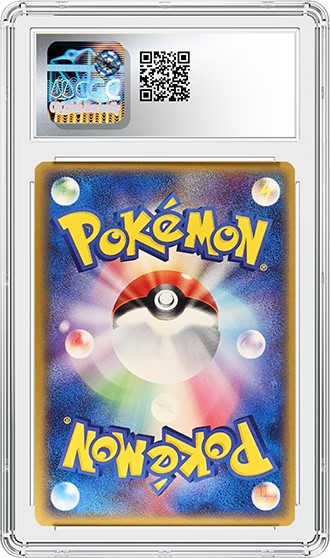 |
| A Victory Orb, Pokémon (2005) Japanese Unnumbered Promo Battle Road Summer Finals Prize Holo graded CGC Gem Mint 10.Click images to enlarge. | |
The Spring and Summer Battle Road competitions were a major source of rare and expensive promotional cards, in case you couldn’t already tell! This promo card featured the original source of Pokémon playground rumors itself: Mew.
This was the first year to feature such a change in promotional card design with these cards featuring a Pokémon instead of a trainer or item. The beautiful Mew card features Mew floating towards the right of the card with various Energy symbols scattering behind it. Holographic foil spreads across the back of the card, and the borders are adorned with the signature Prime foil layer.
The top four winners of the 2005 Summer Battle Road tournament received this exclusive card in a specialized glass plaque. Meanwhile, only the top three winners of the Summer Battle Road 2006 tournament received this promo. Since winners from each tournament bracket (Juniors, Seniors, and Masters) received the Victory Orb Mew, we can assume that there are at least 21 of these cards in circulation; a very low number compared to the 109 No. 1-3 Trainers we described earlier.
One of these Victory Orb Mew promos realized a staggering $40,000 in a March 2022 Heritage Auctions sale. That’s a huge amount for the card on its own, but with the original glass plaque, it can realize even more. In 2020, the full card and plaque set sold on PWCC for an incredible $60,000.
Number 13: 1999 No. 3 Trainer Promo — 1999 Tropical Mega Battle Tournament ($50,300)
 |
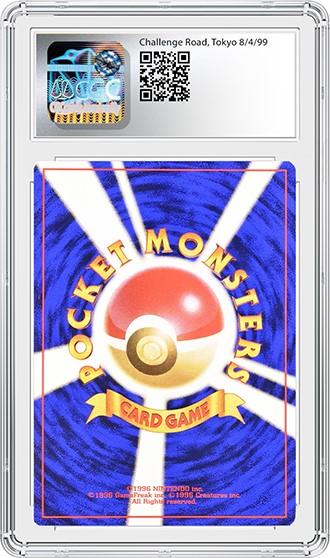 |
| A No. 3 Trainer, Pokémon (1999) Japanese Tropical Mega Battle Holo graded CGC 8.5.Click images to enlarge. | |
We’ve talked about the numbered trainer promos already in this article, but none are more important to the Pokémon Trading Card Game’s history than the 1999 Tropical Mega Battle promo.
The 1999 Tropical Mega Battle was the first tournament to use the rules and structure that would evolve into the Pokémon World Championships we know and love today. The Japan regionals were open to children ages 6-12, while older players competed in the separate Super Secret Battle tournament. First-place winners received invitations to Hawaii to compete in the championship.
The No. 1-3 Tropical Mega Battle promotional cards were structured very similarly to the trainer promos we described earlier, with the text personalized to show the winner’s name, region, and tournament placement. However, there was one key difference. Instead of depicting a trainer, the artwork instead depicted an Exeggutor drawn by the series’ original concept artist Ken Sugimori and illustrator Hiromi Ito.
There were nine tournaments held across Japan, which means that there are only nine copies of this No. 3 Tropical Mega Battle promo in circulation. One of these rarities sold in a 2020 PWCC auction for just over $50,000.
Number 12: Autographed “No Rarity” Venusaur — Japanese 1st Edition Base Set ($55,000)
If you ask any international Pokémon card collector what they believe is the most sought-after set of cards, many of them will answer with “1st Edition Base Set.” In the international release, the first prints of early Pokémon sets were marked with a small 1st Edition symbol in the left-hand corner, just underneath the Pokémon’s art box. They’re generally perceived as rare and expensive since there were very limited prints of the first edition sets.
However, in Japan, collectors didn’t have a 1st Edition set to search for. Instead, they had “No Rarity” versions of Base Set cards to chase after — distinguishable by the lack of the black star symbol on the bottom right corner of the card. Like the international 1st Edition cards, “No Rarity” versions of Base Set cards were the first set of cards printed and released to the Japanese public. Unlike the international version, though, “No Rarity” cards are incredibly scarce.
This particular Venusaur is not only one of these rare variants, but it's also graded and autographed by Masuhiro Arita, illustrator of the original Venusaur artwork depicted on the front of the card. It realized $55,000 in a 2021 PWCC auction, and it’s guaranteed to see a high return if it ever goes to auction again.
Number 11: Tropical Wind — 1999 Challenge Road Promo ($65,000)
 |
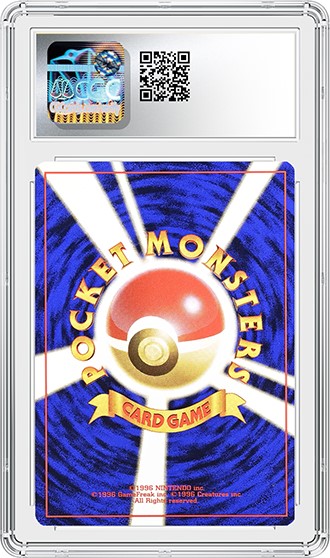 |
| A Tropical Wind, Pokémon (1999) Japanese Tropical Mega Battle Participation Prize graded CGC 9.Click images to enlarge. | |
The 1999 Tropical Mega Battle Tournament International Event was held in Hawaii, where Japanese and American players faced off in their respective divisions for the title of Japanese National Champion and American National Champion. Tournament matches took place across two days, in which matches, special events, and activities were held.
One of the most popular cards run by Japanese players was Tropical Wind, a promotional card exclusive to Japan. Players who reached the final stage of one of the nine regional tournaments in the 1999 Summer Battle Road (the same one that awarded players the No. 3 Trainer we covered earlier) would receive this card as a prize for making it that far. 64 participants received a copy of this promotional card in this way.
Additionally, 10 copies of this promo card were also given away to Japanese players as part of a mail-in lottery campaign known as “99 Presents.” Not much else is known about this mail-in campaign.
With only 74 copies known to exist in circulation, it’s no surprise to see Tropical Wind realizing astronomical prices in auction. A graded copy of the card sold for over $65,000 in October 2020. Another lower-graded copy realized $43,200 in a more recent PWCC auction.
Number 10: Umbreon Gold Star — POP Series 5 / 2005 Japanese Play Promo ($78,000)
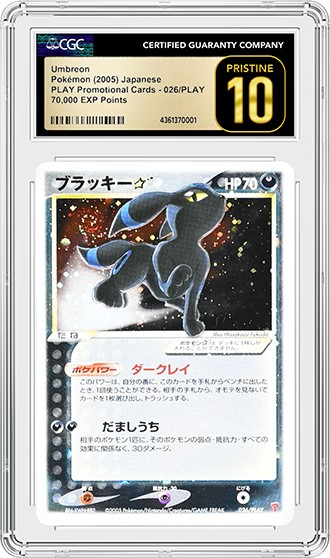 |
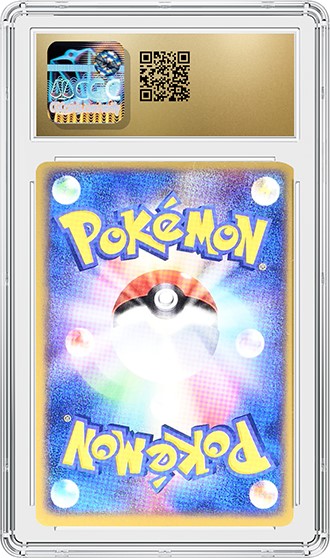 |
| An Umbreon, Pokémon (2005) Japanese PLAY Promotional Cards - 026/PLAY - 70,000 EXP Points graded CGC Pristine 10.Click images to enlarge. | |
The counterpart to Gold Star Espeon, Umbreon Gold Star is another rarity that continues to keep collectors on their toes to this day. Like Gold Star Espeon, players who wanted to get their hands on Umbreon Gold Star needed to subscribe to the Daisuke Club and gather a staggering 70,000 EXP points during the 2005-2006 tournament season. Only then could they receive this blue-ringed Eeveelution.
In addition to the Japanese copies being desirable, international copies of Umbreon Gold Star are also garnering interest from collectors, with an English copy realizing $20,000 in a 2020 PWCC auction. Meanwhile, a graded copy of the Japanese variant realized a whopping $78,000 in a December 2021 PWCC auction, one of the highest recorded prices realized for the card.
Number 9: No. 1 Trainer — 1999 Super Secret Battle Promo ($90,000)
While Japanese children ages 6-12 competed in the Tropical Mega Battle tournament, older competitors met in a secret location in Tokyo for their chance to be crowned the National Champion. This tournament, appropriately named the Super Secret Battle, had its own set of promotional cards as prizes for the first, second, and third-place winners.
The No.1 Trainer promo is by far the rarest of the lot. Only nine of these cards exist, as there were nine tournaments held across Japan. The card offers a congratulatory message to the first-place winner along with instructions on how to attend the finals tournament which would also be held in Tokyo.
The card’s artwork featured a holofoil silhouette of Mewtwo, the fan-favorite Legendary Pokémon of the time, illustrated by Hideki Kazama. The Pokémon TCG’s Japanese logo sits to the right of the silhouette, with “Secret Super Battle” written in English underneath. This is one of the only cards in the entire TCG to feature a silhouette of a Pokémon instead of the filled-in artwork.
Regardless of grade or condition, this Secret Super Battle promo is highly prized by collectors and can realize a ton of money in auction. One of the three No. 1 Trainer copies is currently being offered in a Heritage Auctions sale, where bidding has reached over $50,000 for the card. Another copy realized $90,000 in a 2020 Heritage Auctions sale.
Number 8: No. 2 Trainer — 2006 Pokémon World Championships Promo ($110,000)
This is the second-rarest tournament Trainer promo card in existence, and for good reason.
The 2006 Pokémon World Championships were held in Anaheim, California in late August. To attend, players from across the world had to gather points by attending official PLAY! Pokémon events in their regions. If they amassed enough points to attend the California conference, they would compete in three days of play where only the top 32 players made it to the third-day single-elimination tournament.
To obtain this valuable relic, players not only had to reach the top 32 and the third day of tournament play, but also reign undefeated and earn their rightful place as third, second, and first-place champions. The tournament was harsh — one loss meant the end of the road for 29 participants.
Since there were only three winners, only three 2006 Trainer promo cards exist. The No. 2 Trainer card features Pikachu holding a silver trophy, a congratulatory message for the winner, and an invitation to the 2007 Pokémon World Championship event. The bottom right-hand corner also features an official Pokémon World Championships 2006 stamp, guaranteeing the card's authenticity.
One of the only three 2006 Trainer promo cards appeared in a 2021 PWCC auction, where it realized a breathtaking $110,100. It’s unlikely that we’ll see another copy come to auction anytime soon.
Number 7: Lugia 1st Edition — Neo Genesis ($144,300)
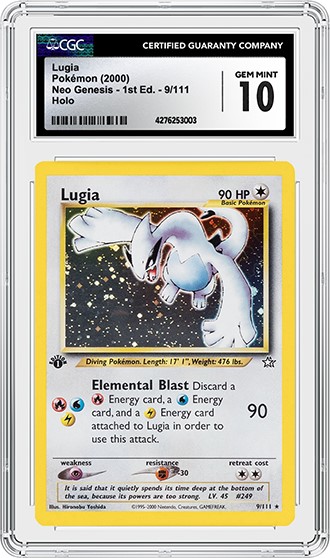 |
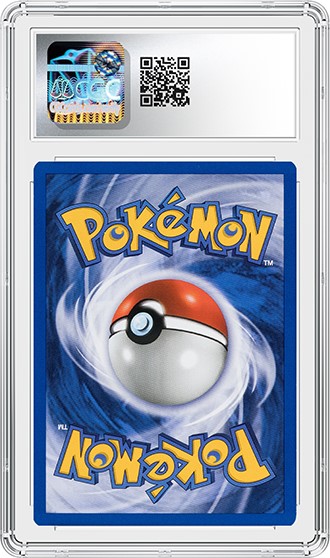 |
| A Lugia, Pokémon (2000) Neo Genesis 1st Edition Holo graded CGC Gem Mint 10. Click images to enlarge. |
|
Similar to Rayquaza Gold Star, Lugia’s popularity stems from it being the preferred box-art legendary from the series’ second generation. The famous Legendary Pokémon is often compared to Charizard in terms of popularity, which means that any media depicting Lugia is often coveted by collectors.
The release of Neo Genesis marked the first official appearance of Lugia in the international release of the Pokémon Trading Card Game, and the card’s design introduced the Beast of the Sea in the best way possible. The card’s artwork features the legendary sitting in front of a stunning tri-color holographic pattern. The red, yellow, and blue colors allude to Lugia’s status as ruler of the three Legendary Titans: Moltres, Zapdos, and Articuno.
The 1st Edition Stamp, however, is what really makes this card desirable. While collectors will jump at the chance to own any version of Neo Genesis Lugia, the 1st edition variant is much more likely to sell for a higher price due to its rarity. Depending on the condition, a graded copy of this elusive card can realize astronomical prices, though sales data is largely unstable.
In May 2021, one of the highest-graded examples of the card sold in a PWCC auction for a mind-blowing $144,300. Meanwhile, the average sales data for a graded 1st Edition Lugia remains largely unstable, with recent prices ranging from $5,000 to $28,000. Regardless, collectors that want to add this card to their collection will find themselves parting with a significant amount of funds.
Number 6: #115 Kangaskhan — 1998 Kamex Tournament Kangaskhan Parent-Child Promo ($150,100)
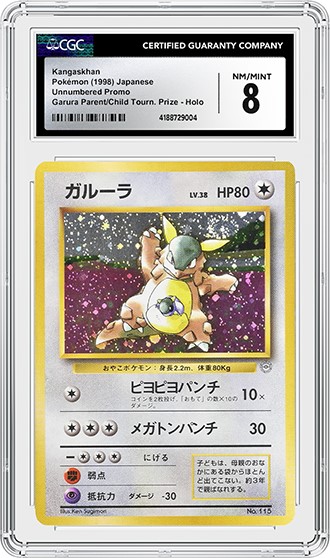 |
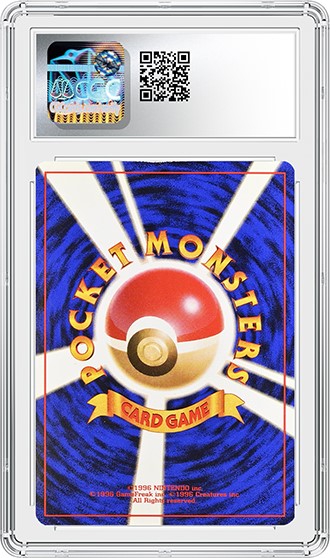 |
| A Kangaskhan, Pokémon (1998) Japanese Unnumbered Promo Garura Parent/Child Tournament Prize Holo graded CGC 8. Click images to enlarge. |
|
Before the famous 1999 Tropical Mega Battle and Super Secret Battle competitions, Pokémon fans attended the 1998 Lizardon and Kamex Mega Battle tournaments to see who was the best Pokémon TCG player in Japan. Similar to the 1999 tournaments, the Lizardon Mega Battle tournaments took place across key regions in Japan and acted as qualifiers, while the Kamex Mega Battle tournament acted as the nationals.
Competitors in the Kamex Mega Battle tournament could participate in side events while waiting for their next match. One of these events was the Kangaskhan Parent-Child tournament, a special event where a child and a player aged 16 or older competed in a tag-team battle against another team. The tournament was held in a round-robin format, and the winning team at each venue received two of the #115 Kangaskhan promos — one each for the older player and the child.
There were five Kamex tournaments hosted across Japan. With two winners each, that means that there are, supposedly, 10 #115 Kangaskhan promo cards in circulation. They’re incredibly rare and valuable to collectors, a fact demonstrated in recent auction sales data. In an October 2020 PWCC auction, one of the #115 Kangaskhan promos realized a staggering $150,100.
Number 5: No. 1-3 Gold, Silver & Bronze Trophy Pikachu — 1998 Lizardon Mega Battle Tournament ($192,000)
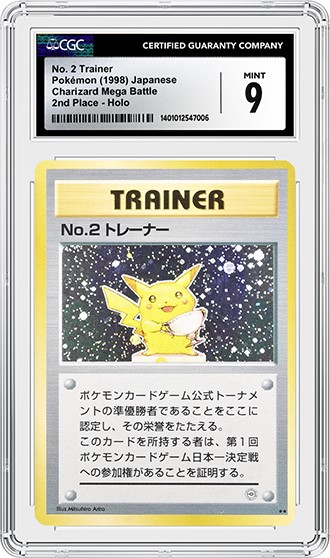 |
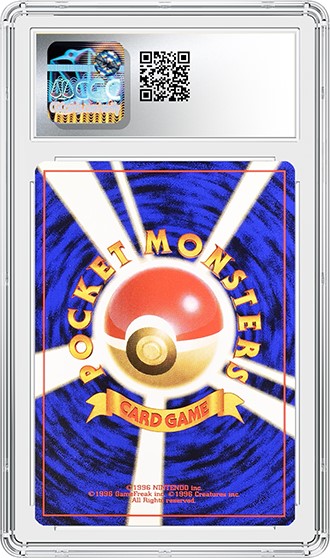 |
| A No. 2 Trainer, Pokémon (1998) Charizard Mega Battle 2nd Place Promo Holo graded CGC 9. Click images to enlarge. |
|
This Trainer promo card is, as far as we know, the rarest and most expensive promotional winner’s prize in the current history of the Pokémon Trading Card Game.
The Lizardon Mega Battle regional tournaments were held in six different venues across Japan. To participate, players had to enter a lottery and be chosen to compete. If they were chosen, the competitors would then battle it out in a single-elimination knockout tournament to determine winners for each division. The top three winners of each division received a Trophy Pikachu card.
Each card features the original “chubby” Pikachu, illustrated by Mitsuhiro Arita, standing on a podium and holding a bronze, silver, or gold trophy depending on the winner’s placement. The text below the card congratulates the player on achieving first, second or third place and invites them to the next year’s tournament.
Across all the regional tournaments, there were nine junior cup tournaments and six senior cup tournaments. This means there are, supposedly, 15 total copies of these cards in circulation, or 5 each of the first, second, and third-place variants. Though this number is higher than the amount of No. 2 Trainer promos from the 2006 tournament season, the value of these early Pikachu Trophy cards cannot be understated. A graded copy of the Bronze Trophy variant sold for a boggling $192,000 in a very recent PWCC auction.
Number 4: Autographed Ishihara GX — 2017 60th Birthday Promo Card ($247,230)
 |
 |
| An Ishihara GX, Pokemon (2017) Black Star Promo - TPCi01 - Signed and sketched by Ishihara 8/26/2018, graded CGC 9. Click images to enlarge. |
|
Promotional cards that feature Pokémon staff members are truly special and unique. Fan-favorites like Imakuni’s Doduo are staples in any collection. While most of these staff promos do make their way to the public, some are never meant to see the outside world.
Tsunekazu Ishihara, the current president of The Pokémon Company, celebrated his 60th birthday in 2017. To commemorate the occasion, he presented everyone in the office with a signed copy of a special promo card. Ishihara GX featured artwork of Ishihara himself holding a Rotom and a Master Ball in a stunning display of classic Sun and Moon-era design. Hilariously, Ishihara’s GX ability “60 Congratulations! GX” tells the player to flip 60 coins and take a present for each head the coin lands on, while also dealing a whopping 1060 damage to an opponent. Only 30 to 60 copies are known to exist, making it incredibly rare.
Obviously, this promo card was never meant for standard or tournament play nor was it meant to leave staff members’ hands. Inevitably, though, the card has popped up in auctions over the years. One signed copy appeared in a Goldin Auctions sale in 2021, where it realized a massive $247,230.
Number 3: Blastoise — 1998 Commissioned Presentation Galaxy Star Hologram ($360,000)
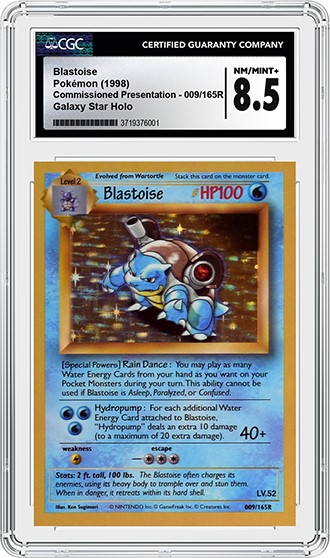 |
 |
| A Blastoise, Pokémon (1998) Commissioned Presentation Galaxy Star Holo graded CGC 8.5.Click images to enlarge. | |
If you haven’t heard about this one-of-a-kind rarity, be prepared to be blown away. This card is the definition of rare Pokémon cards.
Before Wizards of the Coast began publishing English Pokémon cards in 1999, they created test prints to determine what the final print of the TCG line would look like. Early Pokémon TCG test prints included examples of Blastoise, Charizard, and Growlithe. Some test prints were printed early enough to be missing the iconic Pokémon backing. Instead, some test prints feature a Magic: The Gathering backing or a blank back. There are currently five Blastoise test prints accounted for, but none of them are rarer or more expensive than this Galaxy Star hologram.
Wizards of the Coast printed test prints for two reasons; first, to use as a reference when printing cards or making changes, and second, to send to retailers to give them an idea of what the upcoming Pokémon TCG would look like. In the case of this Blastoise test print, Wizards of the Coast commissioned the print to send directly to retailers for display purposes. Only two of these commissioned presentation cards exist, with only one graded and accounted for. Its rarity is unparalleled, and its value is astronomical as a result.
The only graded copy of the Blastoise 1998 Commissioned Presentation Galaxy Star Hologram sold in a 2021 Heritage Auctions sale for $360,000. If it ever comes back to auction, we know it’ll be worth a pretty penny then, too.
Number 2: Charizard 1st Edition Shadowless Holo — 1999 Base Set ($420,000)
 |
 |
| A Charizard, Pokémon (1999) Base Set 1st Edition Holo graded CGC Gem Mint 10. Click images to enlarge. |
|
The one we’ve all been waiting for! Naming a more iconic and sought-after card is difficult indeed.
Known as the holy grail of the Pokémon TCG, the Base Set 1st Edition Charizard continues to inspire and motivate collectors even 25 years after its first appearance. It is one of the most recognizable Pokémon cards out there due to its popularity and value, and it’ll inevitably keep rising in value for years to come.
While any Base Set Charizard is worth its weight in gold, the 1st Edition Shadowless variant is the true gem in collectors’ eyes. Shadowless cards are much rarer than their normal “shadowed” counterparts because shadowless cards were only printed in the very first print run of the Pokémon TCG. Similarly, finding a 1st Edition Shadowless card is even rarer. Combine those two rarities with one of the most popular Pokémon of all time, and it's no wonder that this crown jewel is worth so much to the community.
Base Set Charizard has always sold for a ludicrous amount of money. Previous record sales saw results of $226,000, $350,000, and even $369,000. However, all of those records were obliterated in March 2022, when a collector paid an unimaginable $420,000 for a graded copy on PWCC. While these prices are astronomical, it’s likely that this record will be broken again in due time and collectors are on the edge of their seats waiting for that moment.
Number 1: Pikachu Illustrator — 1998 CoroCoro Comics Promo ($5,275,000)
 |
 |
| A Pokémon Illustrator, Pokémon (1998) Japanese CoroCoro Comics Illustration Contest Promo graded CGC Gem Mint 10. Click images to enlarge. |
|
This Pikachu Illustrator promo is, by far, the rarest and most expensive Pokémon Card to currently exist.
CoroCoro Comic, a popular monthly magazine in Japan, has long been in partnership with The Pokémon Company. Its typical Pokémon-related content includes upcoming series news, fun facts, and occasional promotions. In 1997, the magazine ran a Pokémon art contest. The 39 winners of this mail-in contest each received a Pikachu Illustrator promo. There are currently 41 verified copies of this card in existence.
This particular promo card has always seen high auction results, usually averaging between $200,000 to $250,000. In one 2021 auction, a graded copy saw a record-breaking $375,000 result, only for that record to be completely shattered in 2022 when a CGC-certified example dubbed "The Swirllustrator" realized $672,000 in a Goldin sale. You can read more about the Swirllustrator here.
But $672,000 is nothing compared to the current highest sale price for this card. In April 2022, fans and collectors alike were shocked when Logan Paul, an influencer, wrestler, and famous Pokémon fan, announced that he had purchased a graded Pikachu Illustrator promo for no more than $5,275,000. Yes, you read that right. The sale consisted of Paul trading his previous copy of Pikachu Illustrator — valued at roughly $1,275,000 — and $4 million dollars to collector Marwan Dubsy in Dubai. To commemorate the sale, Paul went on to wear the Pikachu Illustrator to his next wrestling match, the card neatly hung from a likely custom-made Pokeball chain.
This sale is, by far, the most expensive single Pokémon card sale in history. It’s unlikely that anything will come close to this record soon.
Honorable mentions: rare cards without existing sales data
We’re not done yet! There are two more cards we want to cover. They’re special, rare, and will probably be extremely expensive if they ever come to market. However, no one knows that for sure because there’s never been any record of one selling in auction before. For that reason, these two anomalies have a list all to their own.
HM #1: Prerelease Raichu
Back in 1999, Wizards of the Coast began promoting the newest Pokémon TCG set, Jungle, by hosting prerelease events in bookstores and venues across the United States. Fans and guests that attended these events would receive an exclusive Prerelease Clefable — a rare variety of the holographic Clefable card that made its debut once the set was released. The card was unaltered from its typical variant, save for a large “PRERELEASE” stamp in the bottom right corner of the main artwork box.
Of course, no event ever goes without a hitch. A WotC employee was startled to find a major printing error soon after; several Raichu holo cards had also been mistakenly stamped with the Prerelease stamp. WotC officials distributed these misprint cards to internal employees as keepsakes, and they were never spoken of again. When asked about them, Wizards of the Coast maintained the story that these Prerelease Raichu cards didn’t exist, or weren’t available for showing, leaving many to wonder whether they existed at all.
Until the 1999 International Tropical Mega Battle Tournament where, on the first day of festivities, then Wizards of the Coast DCI Tournament Manager Andrew Finch allegedly showed off a copy of the print-error Raichu. Only a few other instances of Prerelease Raichu showing up on the internet have been recorded since then, until now.
On November 1, 2023, CGC Cards released an article confirming the existence of two Prerelease Raichu cards. They have both been certified as legitimate through the use of forensic technology, XRF scanning, consultants and specialized imaging techniques. Prerelease Raichu #1 received a grade of CGC 5.5, while Prerelease Raichu #2 received a grade of CGC 8. To learn more about how these Prerelease Raichu cards were submitted and the certification process, click here.
These cards, once a myth, have finally been proven to really exist. If they ever come to auction, they’re sure to stir intense interest from collectors.
HM #2: Post Malone V, Katy Perry V & J Balvin V — 25th Anniversary Celebrity Promotional Gift Set
In 2021, Pokémon celebrated its 25th anniversary. Like its 20th anniversary bash, the series celebrated by releasing an exclusive promotional Pokémon TCG set, hosting several online video game events, and collaborating with celebrity figures on promotional media, clothing lines, and much more.
One such celebrity collaboration included Pokémon 25: The Album, a music album full of Pokémon-related or inspired songs sung by various celebrity artists. Three featured artists in the album included American rapper Post Malone, American pop star Katy Perry and Colombian reggae artist J Balvin. All three contributed various musical scores and songs to the album. For their work, The Pokémon Company gifted them with their own promotional cards: Post Malone V, Katy Perry V and J Balvin V, respectively. Each card featured a full-art illustration of the artist, the Pokémon they sang about in their featured song, and a stunning background reminiscent of the song’s theme.
When The Pokémon Company revealed plans to gift these promotional cards to their respective singers, fans eagerly awaited the moment they could get their hands on their own copies. Unfortunately, that never came to pass. The Pokémon Company confirmed in a later statement that the cards were meant as exclusive gifts for their respective celebrities and no more prints would be made available to the public.
This means that there is one copy of each of the three cards in existence, making them incredibly rare and valuable. If any of the three were to go to auction, it would represent a literal one-of-a-kind opportunity for any collector lucky enough to snag it. You can learn more about the celebrity set by reading this article.
That wraps up our picks for the rarest and most expensive Pokémon cards in existence. Do you own any of these rarities? Let us know which one is your favorite, or if there’s anything we missed!
Stay Informed
Get the latest CGC Trading Cards news delivered straight to your inbox.


